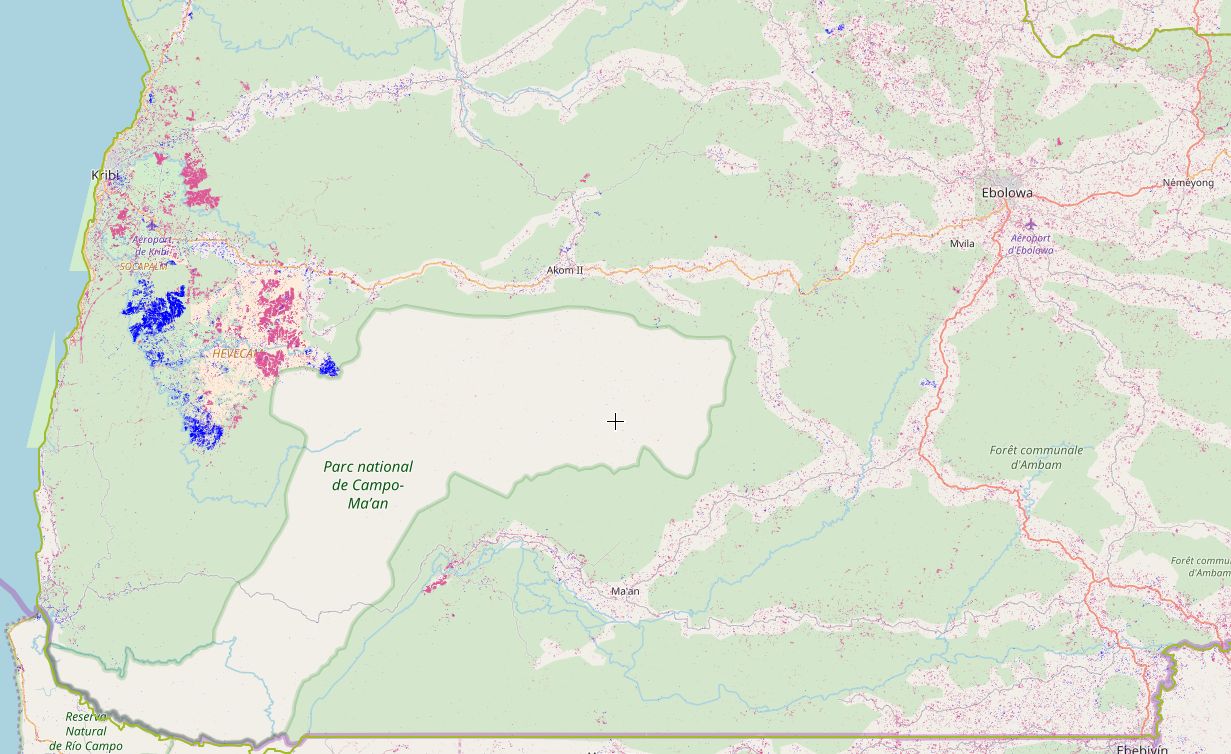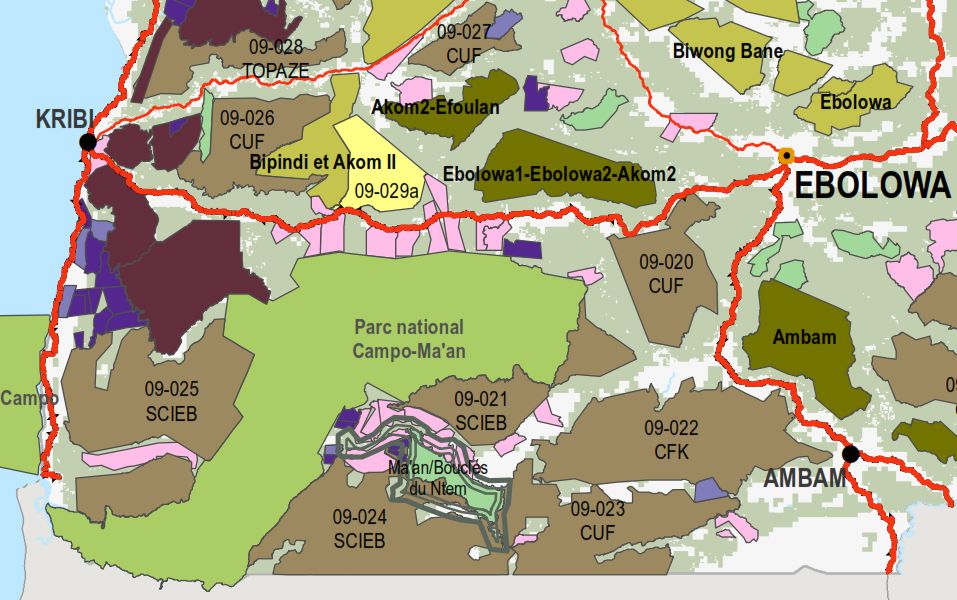Detection of land cover change in Kribi, SW Cameroun
Sentinel-1 CSAR IW acquired on 12 April 2015 at 17:35:38 UTC
Sentinel-1 CSAR IW acquired on 11 June 2015 at 17:35:31 UTC
Sentinel-2 MSI acquired on 29 December 2015 at 09:52:28 UTC
...
Sentinel-1 CSAR IW acquired on 14 January 2018 from 17:35:37 to 17:36:06 UTC
Sentinel-1 CSAR IW acquired on 11 June 2015 at 17:35:31 UTC
Sentinel-2 MSI acquired on 29 December 2015 at 09:52:28 UTC
...
Sentinel-1 CSAR IW acquired on 14 January 2018 from 17:35:37 to 17:36:06 UTC
Keyword(s): Land, forestry, land cover, logging, deforestation, rain forest, agriculture, Cameroon
While optical images allow detecting land change easily, clear days in Gulf of Guinea are few and far between. Sentinel-1 images allow regular relevant acquisitions no matter the weather conditions, enabling users to detect change on a short and regular time period.
Here, water and bitumen appear in darkest, palm trees show predominantly in purple and grassland in green. The rain forest appears as a mix of purple and green while smaller clearing can be identified by the "hole" they leave in the forest texture.
The Forest Law Enforcement, Governance and Trade (FLEGT) program website notes:
"Cameroon has around 20 million hectares of forest, which is almost half of its national territory. Most of this forest area has been permanently allocated to long-term forest production or conservation, with a smaller area intended for community forestry. Cameroon is Africa's largest exporter of tropical hardwood to the EU, most of which is sawn timber that goes to Italy and Spain."
The issue of timber export to Europe is raised as it reminds: "Cameroon’s forests provide millions of people with jobs and subsistence products, and account for 8% of the country’s gross domestic product (GDP). Between 1990 and 2010, however, 18% of Cameroon’s forests were destroyed and many millions more hectares of forest were degraded. From 2010-2015 forest cover continued to decline by an average of 1.1% each year. Illegal logging, enabled by poor forest governance and driven by trade, is a major contributor to deforestation. Around 58% of Cameroon’s timber exports are sent to the EU. The value of those exports in USD 532 million. The Cameroon-EU trade in timber, therefore, has a role to play in addressing the problem of illegal logging."


Loss (red) and gain (blue) in forest cover in the region of Kribi between 2013 & 2016 - source: Global Forest Watch
FLEGT program website explains the impact of illegal logging, writing: "Illegal logging is the harvesting, processing, transporting, buying or selling of timber in contravention of national and international laws. It has a devastating impact on some of the world's most valuable remaining forests, and on the people who live in them and rely on the resources that forests provide. The environmental effects of illegal logging include deforestation, the loss of biodiversity and the emission of greenhouse gases. Illegal logging has contributed to conflicts with indigenous and local populations, violence, human rights abuses, corruption, funding of armed conflicts and the worsening of poverty."
Global Forest Watch adds : "Illegal logging undermines the legitimacy of the forest sector and hinders the efforts of governments to implement sustainable forest management."

Wood Truck near the village of Ngon. District of Ebolowa, Cameroon by Ollivier Girard for Center for International Forestry Research (CIFOR) - source: FLEGT
The FLEGT website reminds: "The EU's FLEGT Action Plan was established in 2003. It aims to reduce illegal logging by strengthening sustainable and legal forest management, improving governance and promoting trade in legally produced timber."
To avoid remaining victim of the tragedy of the commons, Cameroon is among countries that are working toward sustainable logging, joining the UE-funded FLEGT program to do so: "Cameroon has signed a Voluntary Partnership Agreement (VPA) with the EU. The aims of the VPA are to strengthen forest governance, promote Cameroon's timber products and improve Cameroon's competitiveness in the international marketplace. The VPA also encourages investment in sustainable forest management and strengthens the capacity of forest stakeholders."
"Key dates in Cameroon’s efforts to tackle illegal logging
- 2002: Cameroon establishes independent observer initiatives
- 2010: Cameroon and the EU sign the VPA
"
Explaining the basis of the Voluntary Partnership Agreement, the FLEGT website writes:
"A VPA aims
- to guarantee that any wood exported from a timber-producing country to the EU comes from legal sources
- to help the partner country stop illegal logging by improving forest governance and regulation".
Then, it details its content:
"A legality assurance system (LAS) is the central part of a VPA between the EU and a timber-exporting country outside the EU. The LAS is designed to identify, monitor and license legally produced timber, to ensure that only legal timber is exported. Although the VPA is an agreement with the EU, the partner country may choose to set up a system that can be used to verify the legality of timber for other markets as well.
Each country entering into a VPA designs and develops its own system during VPA negotiations, based on its existing control mechanisms and legislative framework. The technical details of the LAS are contained in the final VPA.
An effective system usually includes the verification of forest operations, as well as the control of timber transport and processing as it passes from one owner to the next, all the way from harvesting through to the point of export. A timber LAS usually includes five elements:
- a definition of what constitutes legal timber
- a procedure for verifying control of the supply chain
- tools for verification and the capacity to use them
- licensing by a national authority
- independent audit
FLEGT has made easier for its partners to take measures against individuals responsible for illegal logging. In the case of Cameroon, the FLEGT website reminds: "Cameroon punishes illegal loggers and administration staff exposed by independent forest monitors. Cameroon’s Ministry of Forestry and Wildlife (MINFOF) has raided companies, issued fines, suspended logging authorisations and opened court cases in response to recent reports by independent forest monitors there. The reports have also led the MINFOF to take disciplinary action against its own agents. In March 2017, the Minister of Forestry and Wildlife Philip Ngole Ngwese dismissed nine heads of forest control and hunting posts in areas where independent monitors had reported on suspected illegal logging."


Forest domains of Cameroon in December 2015 - source: Cameroon's Ministry of forests and fauna & World Resources Institute
A report based on inputs from 19 civil society organisations and individuals has been issued in 2017, it covers eight countries in West and Central Africa. According to the FLEGT program website:
"The review concludes that VPAs have helped to broaden the scope of independent forest monitoring and how it sheds light on the forest sector, in particular 'by strengthening the ability of forest communities to ask for and receive information relevant to them'. The report notes that monitors in all countries have adopted VPA legality grids as tools against which to measure compliance. It says this approach provides extra weight to monitoring efforts by raising the possibility of trade restrictions into the EU market, and by the focusing the attention of national stakeholders."
It adds: "'There are early signs that, compared to the past, VPAs and the institutions established to support them, do provide new, more responsible and responsive audiences who would act on governance failures documented through independent forest monitoring.' Finally, the report says FLEGT has significantly increased funding available for independent forest monitoring, and that this has helped local organisations and communities take over from international NGOs."











